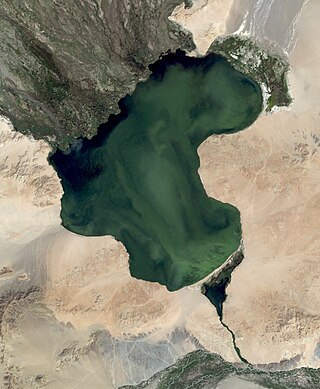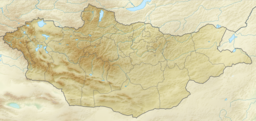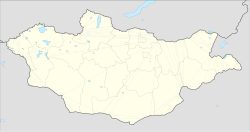
Zavkhan, also spelt Zaukhan or Zabhkhan, is one of the 21 aimags (provinces) of Mongolia, located in the west of the country, 1,104 km from Ulaanbaatar. Its capital is Uliastai. The aimag is named after the Zavkhan River, which forms the border between Zavkhan and Gobi-Altai aimag.

Uvs Lake is a highly saline lake in an endorheic basin—Uvs Nuur Basin, primarily in Mongolia with a smaller part in Russia. It is the largest lake in Mongolia by surface area, covering 3,350 km2 at 759 m above sea level. The northeastern tip of the lake is situated in the Tuva Republic of the Russian Federation. The largest settlement near the lake is Ulaangom. This shallow and very saline body of water is a remainder of a huge saline sea which covered a much larger area several thousand years ago.

Hulun Lake or Dalai Lake is a large lake in the Inner Mongolia region of northern China.

Achit Lake is a freshwater lake in Bayan-Ölgii Province and Uvs Province, Mongolia, in the west of the country. At an elevation of 1,435 m above sea level it covers an area of 290 km2. It is 28 km long, 16 km wide, and 10 m deep. The coast is covered with steppes, mostly hilly but swampy on the northwest and northeast. Several rivers flow into the lake.
Terkhiin Tsagaan Lake (Mongolian: Тэрхийн Цагаан нуур, romanized: Terkhiin Tsagaan nuur,, is a fresh-water lake in the Khangai Mountains in central Mongolia, located in Tariat soum of Arkhangai province. In 670 km to the capital city Ulaanbaatar and 180 km to the center of Tariat soum.

Khar Lake is located in the Zavkhan aimag (province) in western Mongolia. Khar Lake occupies a dale in the Khangai Mountains to the East from the Great Lakes Depression.

The Great Lakes Depression, also called the Great Lakes' Hollow, is a large semi-arid depression in Mongolia that covers parts of the Uvs, Khovd, Bayan-Ölgii, Zavkhan and Govi-Altai aimags. Bounded by the Altai in the West, Khangai in the East and Tannu-Ola Mountains in the North, it covers the area of over 100,000 km2 (39,000 sq mi) with elevations from 750 to 2,000 m (2,460–6,560 ft).

The Central Asian Internal Drainage Basin or Central Asian Inland Basin is the largest of 3 major hydrological basins that cover Mongolia. It is an endorheic basin. It is further subdivided into local drainage basins.

Üüreg Lake is a saline lake in an endorheic basin in Sagil, Uvs Province, Mongolia, north-west of the Great Lakes Hollow, near the western edge of the Uvs Nuur basin. The Tsagaan river gorge lies on the west side of the lake.

Khar-Us Lake (Mongolian: Хар-Ус нуур, romanized: Har-Us nuur; ᠬᠠᠷᠠᠤᠰᠤᠨᠠᠭᠤᠷ, "Black-Aqua Lake", is a lake in western Mongolia in the Great Lakes Depression. It is the upper one in a system of the interconnected lakes: Khar-Us, Khar, Dörgön, Airag and Khyargas. The lake is located in Har Us Nuur National Park.
Khar Nuur may refer to either of two lakes in Mongolia:

Khar Lake is located in the Khovd aimag (province) in western Mongolia's Great Lakes Depression.

Khyargas Lake is a salt lake in Khyargas district, Uvs Province, Western Mongolia.
Chagan Lake is a lake in Jilin, China. The name "Chagan" is from Mongolian, meaning white / pure lake. It is often referred to as the Sacred Lake or Holy Water Lake by local people. The lake is known for its traditional winter fishing, featuring a technique which dates back to prehistoric times.

Baga Nuur is a lake in the Zavkhan Aimag in Mongolia, separated from Khar lake by a band of sand dunes, the estimated terrain elevation above sea level is 1131 metres.
The Altai-Sayan region is an area of Inner Asia proximate to the Altai Mountains and the Sayan Mountains, near to where Russia, China, Mongolia and Kazakhstan come together. This region is one of the world centers of temperate plant diversity. Its biological, landscape, historical, cultural and religious diversity is unique. 3,726 species of vascular plants are registered in the region including 700 threatened or rare species, 317 of which are endemic; fauna consists of 680 species, 6% of which are endemic. Its ecosystem is comparatively unchanged since the last ice age, and it is the host of endangered species that include the saiga, nerpa, and snow leopard. It is the focus of ongoing international and regional environmental conservation initiatives.

Taatsiin Tsagaan Lake is a large saline lake in Övörkhangai Province in the Gobi Desert of southern Mongolia.

Khar Us Nuur National Park is a national park in Khovd Province, Mongolia. It covers a chain of three large lakes in the Great Lakes Basin of western Mongolia. The lakes, Khar-Us Nuur, Khar Lake and Dörgön Lake are bordered by marshes and reed-beds that are an important breeding sport for birds, over 200 species of which have been identified in the park. Mount Jargalant is on the southern shore of Khar-Us. This park is distinct from Khyargas Nuur National Park, another large lake in the region, but 60 km to the north.

Ulaagchinii Khar Nuur National Park is centered on two large freshwater lakes, Bayan Lake to the west, and Ulaagchin Khar Lake 50 km to the east, in west-central Mongolia. The particular 'Khar Lake' of this park is in Zavkhan Province, located in a depression west of the Tarvagatai Mountains. Ulaagchin Khar is surrounded by sand dunes and mountains.

Dayan Lake is a lake located the district of Sagsai, in the Bayan-Ölgii Province of western Mongolia. It is recognized by BirdLife International as an Important Bird Area since 2009. It is located in the Altai Tavan Bogd National Park.

















